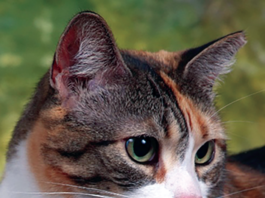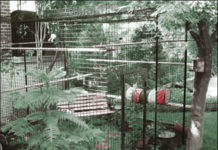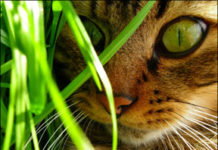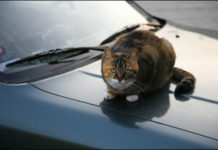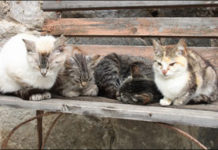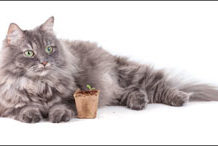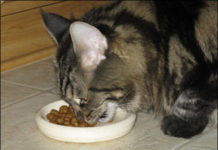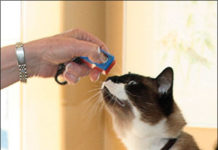Be A Good Neighbor … With Pets
Outdoor hazards - such as dogs, coyotes, cars, and disease - face cats that are allowed to roam outdoors. Most veterinarians, including those at the Cornell Universitys College of Veterinary Medicine, strongly recommend that cats be kept indoors. But if your cat does travel beyond your front door, its likely to wander onto the property of your neighbors. While some people will welcome feline visitors, others wont. What can you do to honor your cats need to roam - and respect your neighbors rights, too? To choose the best method for dealing with a problem, observe your cats behavior carefully to clarify the issue. For example, one womans cat coexisted peacefully with a backyard bird feeder until it suddenly killed three birds in one week. Upon investigation, she discovered that melting snow had left a depression in the ground. The depression prevented the birds from seeing the cat when it crouched in the hole, making them vulnerable to attack. Once the hole was filled in, the birds were safe again.
Cats Eyes: Exquisitely Fascinating
Ever feel like you could get lost in your cats eyes? Although we usually associate cats eyes with the color green, they actually come in many colors. They can range from blue to copper, with a variety of blue-green shades in between. (But all kittens are born with blue eyes - the same as human babies.) The color of the iris (the oval area around the pupil) is caused by the pigment melanin, and in cats it ranges from very pale yellow or tan to deep orange or brown. "The eye also derives some pigment from the retina in the back of the eye, causing a blue-grayish color," says Paul Maza, DVM, of the Department of Biomedical Sciences in Cornell Universitys College of Veterinary Medicine. The end result can be compared to putting a sheet of blue-gray glass over the iris, thus resulting in your cats unique eye color. Since a cats eye color depends on several genetic factors, one set of feline parents can produce a wide range of eye colors in their kittens.
Easy Entertaining For Indoor Cats
A bored cat is often an unhappy cat. Just like humans, cats need stimulation; when left on their own too long, they can experience loneliness and even depression. An unhappy cat may lose or gain weight, stop grooming itself, or become destructive. And a cat with nothing to do will often sleep the day away instead of getting needed exercise. A Daytime Babysitter. For those of us who must leave our pets alone for long hours while at work or elsewhere, the solution could be just a click away: Turn on the TV and put on a movie designed just for cats. Even a cat whos shown no interest in Brad Pitts charms or Jay Lenos jokes may lose its nonchalance when shown a movie specially produced for cats. The difference lies in the camera work. Cat videos are scaled for feline sensibilities and shot from a cats-eye-viewpoint. The camera focuses on prey just as a cat on the hunts gaze would be, with no superfluous car chases or bubbling fountains to distract attention. Because cat eyes have evolved to perceive movement more acutely than detail, cats usually find the simple moving images on screen captivating.
Diagnosis: Bladder Stones
Your cat normally uses the litter box a few times a day to relieve herself, but today is different. Shes going to the box every few minutes and vocalizing as she strains to urinate. The small amount of urine that finally dribbles out is filled with blood. Your cat may be suffering from bladder stones, a painful condition that, left untreated, can lead to serious illness and in rare cases, death. Causes of Bladder Stones. Bladder stones, or uroliths, are caused by an extensive concentration of salts and minerals in the urine such as magnesium, phosphorous, calcium, and ammonia. "There should always be a certain amount of salts and minerals in the urine," says Richard Goldstein, DVM, an associate professor of small animal medicine at Cornell Universitys College of Veterinary Medicine. "But when the urine becomes super saturated - meaning theres an overabundance of salts and minerals - crystals begin to form."
Keep Your Cat Safe During the Hazardous Months of Summer
Your cats safety and good health should be a year-round priority. And unless you keep your cat indoors all of the time, the challenge is likely to be most demanding during the summer months, when temperatures soar, and cats are more likely to wander from the secure confines of their homes. During extremely hot, humid weather, cats are increasingly vulnerable to heat exhaustion and dehydration. They are more prone to assault by fleas, ticks, and other parasites. They can be dangerously exposed to cancer-causing sun rays. And they are more likely to come in contact with such noxious substances as lawn chemicals and rotting garbage. Among the most severe of summertime risks facing the outdoor cat is the threat of being hit by a motor vehicle, says Christine Bellezza, DVM, a consultant at the Feline Health Center of Cornell Universitys College of Veterinary Medicine. "As the weather warms up," she points out, "cats tend to be outside more often. So theyre more likely to roam around, cross streets, and wander into the path of a car."
So You Want to Adopt Another?
Anyone who rescues strays knows there is no shortage of cats. Wanting to provide a home can become a natural outgrowth of feeding them, and most people who adopt them have the best intentions. "They are caring, compassionate people who want to help them," says Pamela Perry, DVM, a lecturer in farm animal behavior at Cornell Universitys College of Veterinary Medicine. But there is a fine line between adequately caring for multiple cats and obsessively accumulating them. Before deciding to bring in just one more, some important factors need to be considered. Health Status. Free-roaming cats are subject to parasites and transmissible diseases with which an indoor-only cat might never come in contact. "When you take in an animal that you dont know, you usually know little about its background, including any diseases it may be carrying," says Dr. Perry. Before integrating the new cat into the household, the newcomer needs to have a thorough veterinary examination, including testing for infection with feline leukemia virus or feline immunodeficiency virus. "If you already have a cat, you dont want to bring another one into the house until it has tested negative for certain diseases," says Dr. Perry. The newcomer also needs to be vaccinated, given flea treatments if necessary and checked for intestinal parasites and ear mites.
Protect Your Plants and Keep Kitty Happy: Grow Grass Indoors
Everyone knows that cats are carnivores. So why does your cat keep snacking on the houseplants? Some experts say greens help cats get rid of hairballs, others that cats crave the fiber and moisture. There may be a nutritional component as well: when feeding on prey, a cat will eat the intestines first, where its likely to find plant matter. But regardless of the reason for the craving, plants can prove a serious danger to cats. Many common houseplants, such as lilies, asparagus ferns, and foxglove, are poisonous. Outdoors, a cat may eat grass or other plants contaminated by pesticides and fertilizer.
Helping Women and Pets
When Sarah* entered a battered womens shelter in Virginia with her three young children, she was frightened, exhausted and inconsolable. As she tried to flee her abusive husband, he had held the familys cat at knifepoint. She had to make a heart wrenching choice. "When he threatened one of my children, I had to leave [the cat]," Sarah tearfully explained to the shelter staff. "A law enforcement officer was sent to the home immediately," relates Allie Phillips, J.D., director of public policy for American Humane, in Alexandria, VA, who witnessed the event at the shelter. "[The police officer] entered the home and found the husband passed out on the floor. The officer also found the cat, who had given birth to a single kitten." When Sarah was reunited at the shelter with her kitty and newborn kitten, "She broke down crying," says Allie. "She said, Now, I have no reason to go back."
Bothersome Eating Behaviors
One cat knocks its food bowl over and makes a mess on your floor every time it eats. Another cat is a thief. It hops onto your kitchen counter at any opportunity to snatch whatever morsel of food it might spot lying there. A third cat spends a good part of its time gnawing on the clothing it finds in your closet. These are among the more common, puzzling, and often very annoying feline eating-related behaviors that, if not appropriately addressed, can seriously compromise the relationship between a cat and its owner. Some such unusual activities, says Katherine Houpt, VMD, James Law Professor of Behavioral Medicine at Cornell University's College of Veterinary Medicine, can signal the presence of a serious physical disorder and will thus merit the attention of a veterinary nutritionist. Others are merely goofy habits that the cat has picked up and can probably be rectified by an owner. And still other undesirable eating habits may stem from deeply rooted "neurotic" problems that can only be successfully reversed with the help of an animal behaviorist - sometimes with the help of certain feline anti-anxiety medications. When is it time to seek the advice and guidance of a behaviorist? "Certainly if the animals habits are seriously endangering the cat-human bond," says Dr. Houpt. "This is an especially urgent matter if the owner is thinking about abandoning a cat to a shelter or, even worse, having it euthanized. Likewise, an owner should seek behavioral consultation if the eating behavior - consuming indigestible materials, for example - could pose a physical threat to the animal."
Here, Kitty, Kitty!
Theres a lighthearted saying that goes something like this: "Dogs come when called. Cats take a message and get back to you." For anyone who has ever shared their home with both canine and feline friends, you know this statement is true! But it doesnt have to be that way. "Your cat is perfectly capable of learning to come when called," says Julia D. Albright, MA, DVM, Resident in Animal Behavior at Cornell Universitys College of Veterinary Medicine. The key, Dr. Albright says, is to use a training method like "clicker training" or "target training" to reward your cat when she performs a certain task. "The clicker [an inexpensive, hand-held device that makes a distinct "clicking" sound] tells a cat what she just did is something her person liked and a treat is coming," says Dr. Albright. "For instance, if you want your cat to touch her nose with her paw, wait until she does it, then immediately "click" and give her a treat." Target training involves using your cats natural curiosity to investigate a "target" such as your finger, a pen or a spoon. When your cat engages in a desired behavior (such as touching her nose or coming up to you), "click" and give a food reward. After several trials, she will begin to associate the act with a reward. You can then begin pairing the action with a command such as "touch" or "come."
The Pleasures (and Perils) of Catnip
Planters of catnip, beware! This perennial is a member of the mint family, like spearmint and oregano, and it reproduces by spreading runners beneath the soil Put one catnip plant in your garden and in five years it may well have taken over. Veteran gardeners plant catnip in buried containers, or in above-ground pots that even the hardiest and most aggressive roots cant escape. Despite the voracious nature of the plant, its worth having around. Carolyn McDaniel, VMD, a consultant at the Feline Health Center at Cornell Universitys College of Veterinary Medicine, says, "Catnip is non-toxic, non-addicting, and low calorie … I think catnip can be a valuable part of an indoor cats environmental enrichment." The entire catnip plant - stem, leaf and seed - is covered with microscopic bulbs that contain nepetalactone. When these bulbs (at the end of sharp hairs called trichomes) reach maturity, they burst, releasing the oil, which then vaporizes upon exposure to air. Just like poison ivy, brushing against the leaves bruises them enough to release the oil from the trichomes, which is why you might see your cat leaning into the catnip. The oil can also be released by insects chewing on the leaves - or by a cat doing the same.
Feline Pancreatitis: Serious
Although the feline pancreas is a relatively small internal organ, typically weighing no more than six or eight ounces, it plays a demanding and multifaceted role in maintaining a cats robust health. Indeed, a disease or injury that results in the inflammation of this vital organ - a condition called pancreatitis - could prove fatal unless the animal receives prompt, and potentially quite expensive, medical care. The pancreas is a slender, pink, v-shaped strip of tissue resting snugly within the cats abdomen between its left kidney and its duodenum. It is a glandular organ that performs two life-sustaining functions-endocrine and exocrine. While still in the pancreas, explains Richard Goldstein, DVM, an associate professor of small animal medicine at Cornell Universitys College of Veterinary Medicine, these digestive enzymes are normally sequestered in tiny droplets that prevent their coming into direct contact with pancreatic tissue. Moreover, he says, the enzymes are biologically programmed to remain inactive until after they have been secreted and have traveled via the pancreatic duct into the small intestine.



